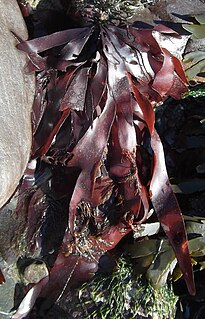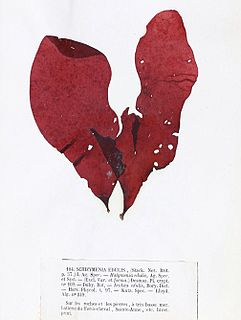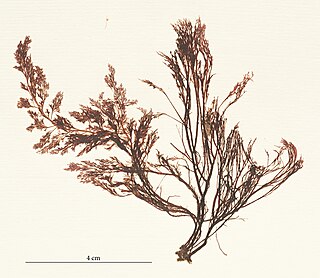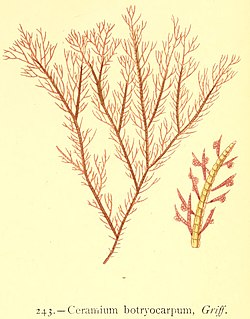
Palmaria palmata, also called dulse, dillisk or dilsk, red dulse, sea lettuce flakes, or creathnach, is a red alga (Rhodophyta) previously referred to as Rhodymenia palmata. It grows on the northern coasts of the Atlantic and Pacific Oceans. It is a well-known snack food. In Iceland, where it is known as söl[ˈsœːl̥], it has been an important source of dietary fiber throughout the centuries.
Schmitzia hiscockiana is a small, rare, red seaweed or marine alga of the phylum Rhodophyta or red algae. It was discovered and named in 1985.

Dilsea carnosa, commonly known as the poor man's weather glass or the sea belt, is a species of red algae in the Dumontiaceae family of the order Gigartinales.
Polysiphonia denudata is a small red alga, Rhodophyta, growing as tufts up to 20 cm long without a main branch axis.

Polysiphonia elongata is a small red marine algae in the Rhodophyta.

Polysiphonia stricta is a small red marine alga in the Division Rhodophyta.

Ceramium botryocarpum is a small red marine alga in the Division Rhodophyta.
Ceramium pallidum is a small marine alga. It occurs in waters off of Europe and Africa (Morocco).

Ceramium virgatum, or the red hornweed, is a small red marine alga.
Brongniartella byssoides Schmitz is a small red marine alga.

Halidrys siliquosa is a large marine brown algae.

Membranoptera alata is a small red alga in the Rhodophyta.
Apoglossum ruscifolium is a small red marine seaweed.

Delesseria sanguinea is a red marine seaweed.

Phycodrys rubens is a red marine alga of up to 30 cm long.

Phyllophora crispa is a medium-sized fleshy, marine red alga. This alga forms dense mats of up to 15 cm thickness, which influence environmental factors, thus creating habitat for several associated organisms.
Phyllophora pseudoceranoides, the stalked leaf bearer, is a small marine red alga.
Phyllophora sicula, the hand leaf bearer, is a small red marine alga.

Odonthalia dentata is a medium-sized marine red alga.
Phymatolithon lenormandii is a common red alga.











